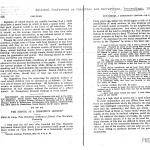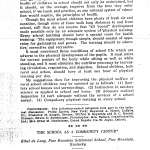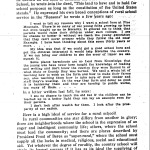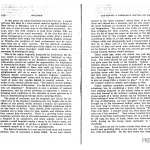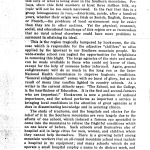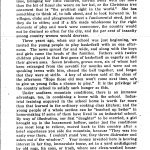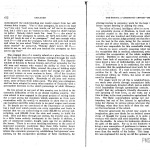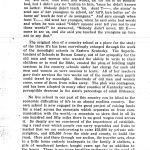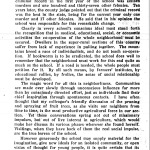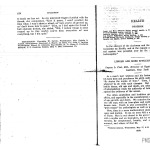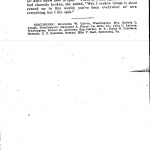Pine Mountain Settlement School
Series 07: DIRECTORS
Ethel de Long Zande
Talk and Publication 1916
“The School as a Community Center”
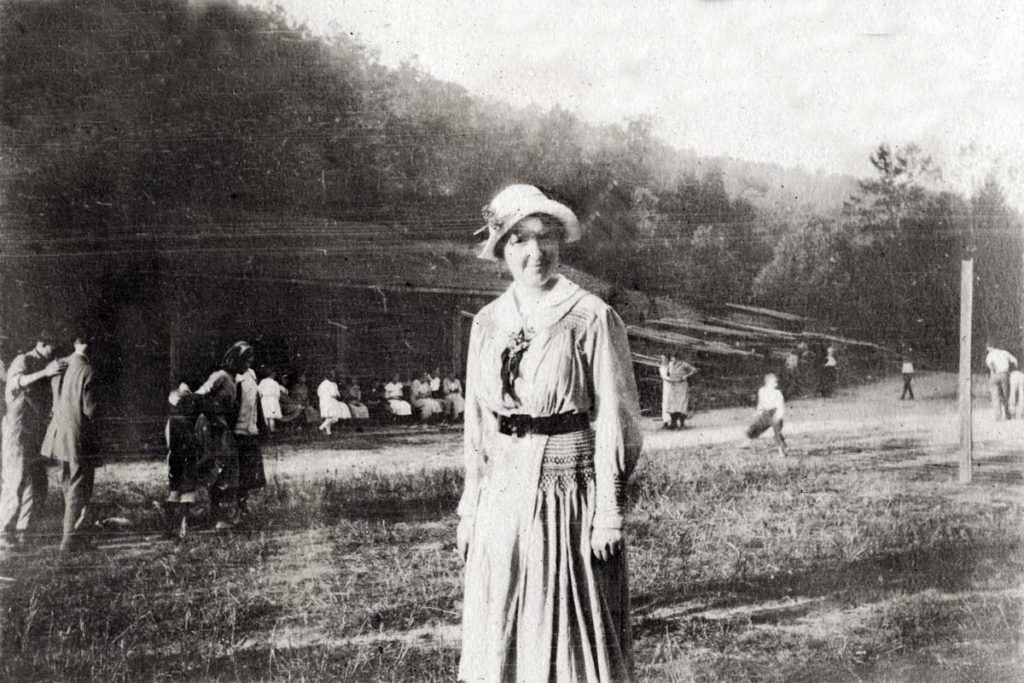
Ethel de Long. [melv_II_album_026.jpg]
TAGS: PMSS Co-Director Ethel de Long Zande, 1916 talk by Zande, community relations, National Conference of Charities and Corrections, clubs and playgrounds, industrial training, moonlight schools, adult illiteracy, road fundraising, fruit-growers’ associations, super-rural communities, Hindman Settlement School, neighborliness, hookworm
ETHEL DE LONG ZANDE Talk 1916 “The School As a Community Center”
de Long, Ethel. “The School as a Community Center.” Presented the 43rd National Conference of Charities and Corrections in Indianapolis, IN, May 16, 1916. Published in the “Proceedings of the National Conference of Charities and Corrections”. 43 (1916), p. 608-614. Print.
Ethel de Long (Zande)‘s presentation to the National Conference of Charities and Correction in Indianapolis on May 16, 1916, was one of many talks that she made on behalf of the Pine Mountain Settlement School. Her primary focus was on literacy and on the impact of community centers on education. This particular conference was attended by 3,228 individuals from forty-seven states and four foreign countries. Julia Lathrop, head of the United States Children’s Bureau, was chair of the conference section on children which sponsored Ethel’s speech.
TRANSCRIPTION [IN PROGRESS]
Page 608 [zan_25a]
THE SCHOOL AS A COMMUNITY CENTER
_________
Ethel de Long, Pine Mountain Settlement School, Pine Mountain,
Kentucky
_________
I wish that the old man who founded the Pine Mountain Settlement School with which I am connected could speak in my place to-day on “The Rural School as a Community Center.”
Page 609 [zan_25b]
THE SCHOOL AS COMMUNITY CENTER
Forty years ago, before the world began to talk of the needs and possibilities of rural sections, he was thinking what the right sort of school would accomplish for his neighborhood, away off in the Kentucky mountains. And when, at sixty-seven years old, he deeded all his land to establish the Pine Mountain Settlement School, he wrote into the deed, “This land to have and to hold for school purposes as long as the constitution of the United States stands.” He expressed his own broad conceptions of rural school service in the “Reasons” he wrote a few years ago:
I want to tell my reasons why I want a school here at Pine Mountain. There is so many of our young folks growing up here not even taught up as to Morality. It grieved me to think that parents would raise their children under such rulings. I see no chance to better it without we teach the young generation that they can’t never prosper while they follow the old ones’ Example. I have been thinking about this some thirty years or more.. . . .
My Idea was that if we could get a good school here and get the children interested it would help Moralize the country. If we can bring our children to see the error of liquor we can squash it.
Some places hereabouts are so Lost from Knowledge that the young uns have never been taught the knowledge of reading and writing and don’t know the country they were Borned in or what State or County they was borned. We need a whole lot of teaching how to work on the farm and how to make their farms pay, also teaching them how to take care of their timber and stuff they’re wasting. In the way they farm and doing no good it is hardening them and they are turning to public works, too many of them. . . . .In a letter written last fall, he says:I see no chance to teach the old but if the children can be teached up in a better light they can lay an example even for their parents.I don’t look after wealth for them. I look after the prosperity of our nation.Here is a high ideal of service for a rural school!
In rural communities one star differs from another in glory; there are neighborhoods where the school is the expression of an eager and intelligent community life; others, where the school must lead the community; and there are places described by President Frost of Berea as “super-rural,” where the school must supply all the lacks in medical, religious, social and educational aid. Yet whatever the degree of rurality, the country school will attain its largest success if it has as its ideal the supplying of those elements of life that are difficult to attain under rural conditions. It can be the interpreter between the life of towns and cities and that of the country, and can serve as a true light-house for those sitting in darkness because of the poverty of communication.
Page 610 [zan_26a]
CHILDREN
At this point, my subject becomes too broad for me. I cannot tell how this ideal of a rural school could be applied in Maine or New Jersey or Michigan, and if I am to speak knowingly, can talk only of what is being done in the Southern mountains. Perhaps, since this field numbers at least three million folk, my toplc will not be too much narrowed. In the fact that this is a group homogeneous in race, — Americans, surely, after a hundred years, whether their origin was Irish or Scotch, English, German, or French, — the problems of local environment may be easier than they are in other sections. Yet the physical, economic, social, and educational handicaps of this region are so tremendous that no rural school elsewhere could have more problems to surmount in attaining its ideal.
This is the region tragically hampered by hookworm, the disease which is responsible for the adjective “shiftless” so often applied by the ignorant to our Southern mountain people. No wide-awake school can neglect the opportunities for helpfulness in removing this blight. The large agencies of the state and nation can be made available to those who could not know of them, except for the help of someone better informed. Again, general enlightenment will do as much in the long run as the International Health Commission to improve hygienic conditions. “General enlightenment” comes with no burst of glory, but as the result of many tiny candles lighted in country schools. As a writer in the current Atlantic says: “The School, not the College, is the hearthstone of Education. It is the first and second-formers who are important.” Hookworm is now a problem of national importance, and the school performs as important a service in bringing local conditions to the attention of great agencies as it does in disseminating knowledge and in securing clinics.
The study of trachoma, and the hospitals and clinics for the relief of it in the Southern mountains are very largely due to the efforts of one school, which induced a famous eye specialist to come into the mountains to relieve the frightful conditions which no one knew of before. Such schools avail themselves also of hospital aid in large cities for men, women, and children whom they cannot help themselves. There is a growing belief among mountain workers that an all-round mountain school must include a hospital in its equipment; and many schools which do not operate a small hospital employ a nurse to do district work, and to preach the gospel of germs, — a gospel as unknown to the mountain people as it was to our grandparents.
The field of medicine is a new one for both town and country schools; that of recreation is better tilled. In our own school,….
Page 611 [zan_26b]
THE SCHOOL A COMMUNITY CENTER–DE LONG
…located in the “pure country,” where there is no town, weekly clubs and classes are a necessity and we also avail ourselves of the great holidays as occasions for giving material for thought and imagination. The woman who walks ten miles at Christmas time, bringing her little children, carries away with her more than the bit of tinsel she wears on her hat, or the Christmas tree ornament that is “the prettiest sight in the world.” She has something to think of, to talk about, and to look forward to. In villages, clubs and playgrounds meet a fundamental need, just as they do in cities; and if a life made wholesome by the right elements of play and work were commoner, the country would not be drained so often for the city, and the per cent of insanity among country women would decrease.
Three years years ago, when our school was just beginning, we invited the young people to play basketball with us one afternoon. The news spread far and wide, and along with the boys and girls came the heads of the families. Fathers with twelve children played in that first game of basketball as eagerly as did their grown sons. Seven brothers, grown men, six of whom had been estranged from the seventh for months and were not on speaking terms with him, chased the ball together, and forgot that they were at strife. A boy of nineteen said at the close of the afternoon “Hope those old men won’t come next time, so’s to give us young folks a chance to play.” It is the privilege of the country school to satisfy such hunger as this.
Under southern mountain conditions, there is an immense advantage, too, in combining a home with the school. Industrial training acquired in the school home is worth far more than that learned in the ordinary cooking class kitchen; and the young people of a whole section can be “teached up better” in home-making if some of them have lived in an industrial school. By way of illustration, our first “daughter” to be married, a girl brought up in the lonesomest hollow, under just the conditions you most long to relieve, moved back to this country after a brief experience yon side the mountain, because “They was too nasty over there. I couldn’t stand ’em; they threw dishwater and ashes out o’ the window.” Your money invested here is bearing interest in her tiny, immaculate house, set in a yard undisfigured by old rags, tin cans, or trash, where one clean-washed housecloth, drying on the fence, bears testimony to its owner’s standards.
One could not ask for better returns than those given us by a quaint and sparkling little seven-year-old, who recently spent a day with her kinsfolk. On the way home her wise little head…
Page 612 [zan_27a]
CHILDREN
…outmeasured the understanding one would expect from her still clumsy baby tongue. “One o’ dem younguns, de next to de least ‘un,” she said, “said some bad words, an’ tol’ me to do sompin’ bad, but I didn’t pay no ‘tention to him, ‘tause he didn’t known no better. Nobody didn’t teach ‘im. Aunt T—, she aimin’ to send one of her younguns to school, an’ hit’ll larn better an’ do home an’ teach de rest o’ de younguns.” And sure enough when Aunt T— did send her youngun, when he said some bad words and when he was asked “Didn’t anyone ever tell you not to say those words?” he answered, “Nobody didn’t never, till E— come to see us, and she said you teached the younguns up here not to say that.”
The original idea of a country school as a place for the study of the three R’s has been marvelously enlarged through the work of the moonlight schools in Eastern Kentucky. The Superintendent of Schools in Rowan County, out of her sympathy for the old men and women who wanted the ability to write to their children or to read the Bible, created the plan of holding night sessions in the country schools under her charge for such old men and women as were anxious to learn. All of her teachers gave their services the two weeks out of the month when pupils could travel by moonlight. Hundreds of old men and women came, some of them from miles away. The plan was contagious, and has been adopted in many other counties of Kentucky with a perceptible decrease in the state’s percentage of adult illiteracy.
No live school in our part of this country can be blind to the economic difficulties of life in an almost roadless country. Our own school is now engaged in the great project of raising funds for a road across the mountain which separates us from communication with the world, — a mountain so stern that in all its one hundred and fifty miles there is no good wagon road across it. So deeply are we convinced of the importance of establishing a road over which people can carry vegetables and fruits to market that we are endeavoring to raise $25,000 by private subscription, and $35,000 from the state and county, to build the road. Here and there through our section, the traveler sees, close to a little home entirely inadequate to the family it shelters, a pile of weathered lumber, bought years ago for an addition to the house. There is no more touching testimony to the need of improved economic conditions than these little lumber heaps with their tale of deferred hopes. Some schools are striving to relieve the economic pressure by establishing fruit-growers’ associations, by the co-operative purchase of farm machinery, by…
Page 613 [zan_27b]
THE SCHOOL A COMMUNITY CENTER–DE LONG
…offering courses in carpentry work for the boys who can see no future except farming or joining the army.
The effect of broad, intelligent effort to serve the community was splendidly shown at Hindman, in Knott county, where the criminal record in the first year of the school was sixteen murders and one hundred and thirty-seven other felonies. Ten years later, the county judge pointed out that the criminal record was the best in the state, being for the current year only one murder and 17 other felonies. He said that in his opinion the school was responsible for this remarkable change.
Clearly in every school’s conscious ideal must stand forth the recognition that in medical, educational, social, or economic activities the co-operation of the whole neighborhood must be secured. Dwellers in the super-rural sections of this country suffer from lack of experience in pulling together. The mountains breed a race of individualists, and do not teach co-operation. If hookworm is to be eradicated, the school does well to remember that the neighborhood must work for this end quite as much as the school. If a road is needed, the whole people must petition for it. By all such means, by farmers’ institutes, by educational rallies, by frolics, the sense of social relationship must be developed.
The magic word for all this is neighborliness. Communities are made over slowly through unconscious influence far more than by consciously directed effort, just as individuals find their chief inspiration through spontaneous contacts. I have often thought that my colleague’s friendly discussion of the pruning and spraying of fruit trees, as she visits our neighbors from time to time, is the most productive agricultural force in our section. Yet these conversations spring not out of missionary impulses, but out of live interest in agriculture, which would make her discuss its various phases wherever she found herself. Visitings, when they have back of them the real social impulse, are the true leaven of the school.
However generously the school may supply material for the imagination, give new ideals for an isolated community, or open vistas of thought for young people, it is quite certain that its workers will receive still more bountiful things. Back and forth flies the shuttle. In return for hookworm clinics and roads come the gifts of the spirit. For us in the Southern mountains they bring a new conception of gentleness in human relationship and of gracious hospitality. In serving remote sections come riches more than the wealth of the Indies. This large philosophy of life was expressed for me by an old flax spinner who was trying…
Page 614 [zan_28a]
CHILDREN
…to teach me her art. As my untrained fingers fumbled with the thread, she commented, “Ain’t it quare, I cain’t recollect the time when I wan’t about a wheel, an’ here you’re all growed up, an’ don’t know how to spin.” Then, as I tied again the thread I had clumsily broken, she added, “Wal, I reckon things is about evened up in this world; you’ve been everywhar an’ seen everything, but I kin spin.”
__________
DISCUSSION: Henrietta W. Calvin, Washington; Mrs. Ophella La Amigh, Birmingham; Raymond A. Hoyer, La Salle, Ill.; Julia C. Lathrop, Washington; Robert K. Atkinson, Sag Harbor, N. Y.; Helen B. Pendleton, Newark; C. C. Carstens, Boston; Ella V. Ball, Richmond, Va.
GALLERY I: Edited Draft of “The School as a Community Center”
PENDING
[Missing Page 1]
GALLERY II: Published Version of “The School As a Community Center”
- Ethel de Long, “The School as Community Center,” National Conference of Charities…, May 16, 1916, pp. 608-609. [zan_025_608-609]
- Ethel de Long, “The School as Community Center, National Conference of Charities…, May 16, 1916, p. 608 [zan_025a]
- Ethel de Long, “The School as Community Center, National Conference of Charities…, May 16, 1916, p. 609 [zan_025b]
- Ethel de Long, “The School as Community Center, National Conference of Charities…, May 16, 1916, pp. 610-611. [zan_026_610-611]
- Ethel de Long, “The School as Community Center, National Conference of Charities…, May 16, 1916, p. 610. [zan_026a]
- Ethel de Long, “The School as Community Center, National Conference of Charities…, May 16, 1916, p. 611. [zan_026b]
- Ethel de Long, “The School as Community Center, National Conference of Charities…, May 16, 1916, pp. 612-613. [zan_027_612-613]
- Ethel de Long, “The School as Community Center, National Conference of Charities…, May 16, 1916, p. 612. [zan_027a]
- Ethel de Long, “The School as Community Center, National Conference of Charities…, May 16, 1916, p. 613. [zan_027b]
- Ethel de Long, “The School as Community Center, National Conference of Charities …, May 16, 1916, pp. 614-15. [zan_028_614-615]
- Ethel de Long, “The School as Community Center, National Conference of Charities…, May 16, 1916, p. 614. [zan_028a]
SEE ALSO:
CORRESPONDENCE
ETHEL DE LONG ZANDE Bassett Collection Guide [Largely family correspondence]
ETHEL DE LONG ZANDE 1911-1928 Administration Correspondence
[Not included in the ETHEL DE LONG ZANDE Bassett Collection Guide]
PUBLICATIONS
DEAR FRIEND Letters Index Promotional literature.
ETHEL DE LONG ZANDE Publications Guide
ETHEL DE LONG ZANDE “Doings on Troublesome,“ Smith Alumnae Quarterly, July 11, 1912.
ETHEL DE LONG ZANDE “Pine Mountain School: A Sketch From the Kentucky Mountains,” Outlook, Feb. 21, 1917, pp. 318-20. (Also a talk by Zande.)
ETHEL DE LONG ZANDE “The Far Side of Pine Mountain,” The Survey. 37 (October 1916)
ETHEL DE LONG ZANDE “Mountain Manners,” Smith Alumnae Quarterly.
RELATED
ETHEL DE LONG ZANDE Photograph Album
HELEN DE LONG Photograph Album
HELEN DE LONG AND DE LONG FAMILY Book Donation – Donated to Pine Mountain in 1942
KATHERINE PETTIT Correspondence Guide
ZANDE HOUSE – The Zandes’ residence on PMSS campus.
OTHER TALKS
ETHEL DE LONG ZANDE “Pine Mountain School: A Sketch From the Kentucky Mountains” – 1915 talk and 1917 publication.

